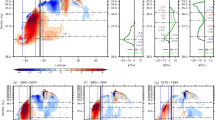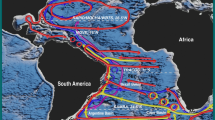Abstract
The hydrographic properties of the North Atlantic Ocean changed significantly from 1950 to 2000: the subtropics warmed and became more saline, whereas the subpolar ocean cooled and freshened. These changes directly affect the storage of heat and fresh water in the ocean, but their consequences for ocean dynamics are determined by the resultant changes in seawater density. Here we use historical hydrographic data to show that the overall seawater density in the North Atlantic basin decreased during this 50-year period. As a result of these density changes, sea-surface heights changed in a spatially varying pattern with typical rates of 2 mm yr−1, in broad agreement with tide-gauge measurements. Melding the observed density fields within a numerical model we find a slight weakening in the overturning of the subtropical gyre by −1.5±1 Sv and a slight strengthening in the overturning of the subpolar gyre by +0.8±0.5 Sv. These gyre-specific changes run counter to the canonical notion of a single, basin-scale overturning cell and probably reflect interannual and decadal trends rather than any long-term climate trend. We conclude that gyre dynamics strongly affect temperature and salinity changes that translate into changes in the meridional overturning circulation.
This is a preview of subscription content, access via your institution
Access options
Subscribe to this journal
Receive 12 print issues and online access
$259.00 per year
only $21.58 per issue
Buy this article
- Purchase on Springer Link
- Instant access to full article PDF
Prices may be subject to local taxes which are calculated during checkout





Similar content being viewed by others
Change history
14 October 2010
In the version of this Letter originally published, "-0.8 ± 0.5 Sv" in the fifth sentence of the abstract should have read "+0.8 ± 0.5 Sv". This error has now been corrected in the HTML and PDF versions of the text.
References
Sabine, C. L. et al. The oceanic sink for anthropogenic CO2 . Science 305, 367–371 (2004).
Levitus, S., Antonov, J. I., Boyer, T. P. & Stephens, C. Warming of the world ocean. Science 287, 2225–2229 (2000).
Levitus, S., Antonov, J. & Boyer, T. Warming of the world ocean, 1955–2003. Geophys. Res. Lett. 32, L02604–L02607 (2005).
Dickson, B. et al. Rapid freshening of the deep North Atlantic Ocean over the past four decades. Nature 416, 832–837 (2002).
Curry, R., Dickson, B. & Yashayaev, I. A change in the freshwater balance of the Atlantic Ocean over the past four decades. Nature 426, 826–829 (2003).
Boyer, T. et al. Changes in freshwater content in the North Atlantic Ocean 1955–2006. Geophys. Res. Lett. 34, L16603–L16607 (2007).
Bi, D., Budd, W. F., Hirst, A. C. & Wu, X. Collapse and reorganisation of the Southern Ocean overturning under global warming in a coupled model. Geophys. Res. Lett. 28, 3927–3930 (2001).
Gregory, J. M. et al. A model intercomparison of changes in the Atlantic thermohaline circulation in response to increasing atmospheric CO2 concentration. Geophys. Res. Lett. 32, L12703–L12707 (2005).
Cunningham, S. A. et al. Temporal variability of the Atlantic meridional overturning circulation at 26.5° N. Science 317, 935–938 (2007).
Bryden, H. L., Longworth, H. R. & Cunningham, S. A. Slowing of the Atlantic meridional overturning circulation at 25 N. Nature 438, 655–657 (2005).
Lumpkin, R., Speer, K. G. & Koltermann, K. P. Transport across 48° N in the Atlantic Ocean. J. Phys. Oceanogr. 38, 733–752 (2008).
Cunningham, S. A. & Marsh, R. Observing and modeling changes in the Atlantic MOC. Wiley Interdiscip. Rev. Clim. Change 1, 180–191 (2010).
Biastoch, A., Böning, C. W., Getzlaff, J., Molines, J-M. & Madec, G. Causes of interannual–decadal variability in the meridional overturning circulation of the midlatitude North Atlantic Ocean. J. Clim. 21, 6599–6615 (2008).
Bingham, R. J., Hughes, C. W., Roussenov, V. & Williams, R. G. Meridional coherence of the North Atlantic meridional overturning circulation. Geophys. Res. Lett. 34, L23606–L23611 (2007).
Baehr, J., Stroup, A. & Marotzke, J. Testing concepts for continuous monitoring of the meridional overturning circulation in the South Atlantic. Ocean Modelling 29, 147–153 (2009).
Lozier, M. S. et al. The spatial pattern and mechanisms of heat-content change in the North Atlantic. Science 319, 800–803 (2008).
Boyer, T. et al. in NOAA Atlas NESDIS 60 (ed. Levitus, S.) 190–190 (US Government Printing Office, 2006).
Gregory, D. N. Canadian Science Advisory Secretariat Research Document—2004/075 (2004).
Hurrell, J. W. Decadal trends in North Atlantic oscillation: Regional temperatures and precipitation. Science 269, 676–679 (1995).
Hurrell, J. W., Kushnir, Y., Ottersen, G. & Visbeck, M. (eds) The North Atlantic Oscillation: Climate Significance and Environmental Impact (Geophysical Monograph Series 134, American Geophysical Union, 2003).
Church, J. A., White, N. J., Coleman, R., Lambeck, K. & Mitrovica, J. X. Estimates of the regional distribution of sea level rise over the 1950–2000 period. J. Clim. 17, 2609–2625 (2004).
Church, J. et al. Understanding global sea levels: Past, present and future. Sustain. Sci. 3, 9–22 (2008).
Marotzke, J. et al. Construction of the adjoint MIT ocean general circulation model and application to Atlantic heat transport sensitivity. J. Geophys. Res. 104, 529–547 (1999).
Baehr, J., Hirschi, J. J. M., Beismann, J-O. & Marotzke, J. Monitoring the meridional overturning circulation in the North Atlantic: A model-based array design study. J. Mar. Res. 62, 283–312 (2004).
Kanzow, T. et al. Observed flow compensation associated with the MOC at 26.5° N in the Atlantic. Science 317, 938–941 (2007).
Marshall, J., Hill, C., Perelman, L. & Adcroft, A. Hydrostatic, quasi-hydrostatic, and nonhydrostatic ocean modeling. J. Geophys. Res. 102, 5733–5752 (1997).
Koehl, A., Dommenget, D., Ueyoshi, K. & Stammer, D. Ocean Synthesis. Report No. 40, (2006). http://www.ecco-group.org/ecco1/report/report_40.pdf).
Roussenov, V. M., Williams, R. G., Hughes, C. W. & Bingham, R. J. Boundary wave communication of bottom pressure and overturning changes for the North Atlantic. J. Geophys. Res. 113, C08042–C08053 (2008).
Willis, J. K. Can in situ floats and satellite altimeters detect long-term changes in Atlantic Ocean overturning? Geophys. Res. Lett. 37, L06602 (2010).
Bingham, R. J. & Hughes, C. W. Signature of the Atlantic meridional overturning circulation in sea level along the east coast of North America. Geophys. Res. Lett. 36, L02603–L02607 (2009).
Hatun, H., Sando, A. B., Drange, H., Hansen, B. & Valdimarsson, H. Influence of the Atlantic subpolar gyre on the thermohaline circulation. Science 309, 1841–1844 (2005).
Fofonoff, N. P. & Millard, R. C. J. Algorithms for Computation of Fundamental Properties of Seawater Vol. 44, 53 (Unesco Technical Papers in Marine Science, 1985).
Lozier, M. S., Owens, W. B. & Curry, R. G. The climatology of the North Atlantic. Prog. Oceanogr. 36, 1–44 (1995).
Acknowledgements
The authors gratefully acknowledge support from the US National Science Foundation and the UK Natural Environment Research Council.
Author information
Authors and Affiliations
Contributions
M.S.L. led the data study and its interpretation and R.G.W. led the modelling study and interpretation. V.R. conducted the modelling study and developed the model-data analysis. M.S.C.R. conducted the historical-data analysis. M.S.L. and R.G.W. jointly wrote the paper.
Corresponding authors
Ethics declarations
Competing interests
The authors declare no competing financial interests.
Supplementary information
Supplementary Information
Supplementary Information (PDF 889 kb)
Rights and permissions
About this article
Cite this article
Lozier, M., Roussenov, V., Reed, M. et al. Opposing decadal changes for the North Atlantic meridional overturning circulation. Nature Geosci 3, 728–734 (2010). https://doi.org/10.1038/ngeo947
Published:
Issue Date:
DOI: https://doi.org/10.1038/ngeo947
This article is cited by
-
Energetic overturning flows, dynamic interocean exchanges, and ocean warming observed in the South Atlantic
Communications Earth & Environment (2023)
-
The evolution of the North Atlantic Meridional Overturning Circulation since 1980
Nature Reviews Earth & Environment (2022)
-
AMOC modes linked with distinct North Atlantic deep water formation sites
Climate Dynamics (2022)
-
A shift in the ocean circulation has warmed the subpolar North Atlantic Ocean since 2016
Communications Earth & Environment (2021)
-
Increased ocean heat transport into the Nordic Seas and Arctic Ocean over the period 1993–2016
Nature Climate Change (2021)



